Cloud Based Solution for Cake Franchise System
VerifiedAdded on 2023/01/13
|12
|3322
|30
AI Summary
This report discusses the use of cloud based solutions for the Cake Franchise System, highlighting the different aspects, strengths, and weaknesses. It also compares and contrasts Scrum and Unified Process methodologies for software development.
Contribute Materials
Your contribution can guide someone’s learning journey. Share your
documents today.

Assessment
Secure Best Marks with AI Grader
Need help grading? Try our AI Grader for instant feedback on your assignments.

Table of Contents
Introduction......................................................................................................................................1
Cloud Based Solution......................................................................................................................1
Illustrate different aspects along with their strengths & weaknesses for cloud based solution
with respect to environment for Cake Franchise System............................................................1
Agile Methodologies........................................................................................................................5
Comparison and contrast between Scrum and Unified Process..................................................5
Recommendation.........................................................................................................................8
Conclusion.......................................................................................................................................9
References......................................................................................................................................10
Introduction......................................................................................................................................1
Cloud Based Solution......................................................................................................................1
Illustrate different aspects along with their strengths & weaknesses for cloud based solution
with respect to environment for Cake Franchise System............................................................1
Agile Methodologies........................................................................................................................5
Comparison and contrast between Scrum and Unified Process..................................................5
Recommendation.........................................................................................................................8
Conclusion.......................................................................................................................................9
References......................................................................................................................................10
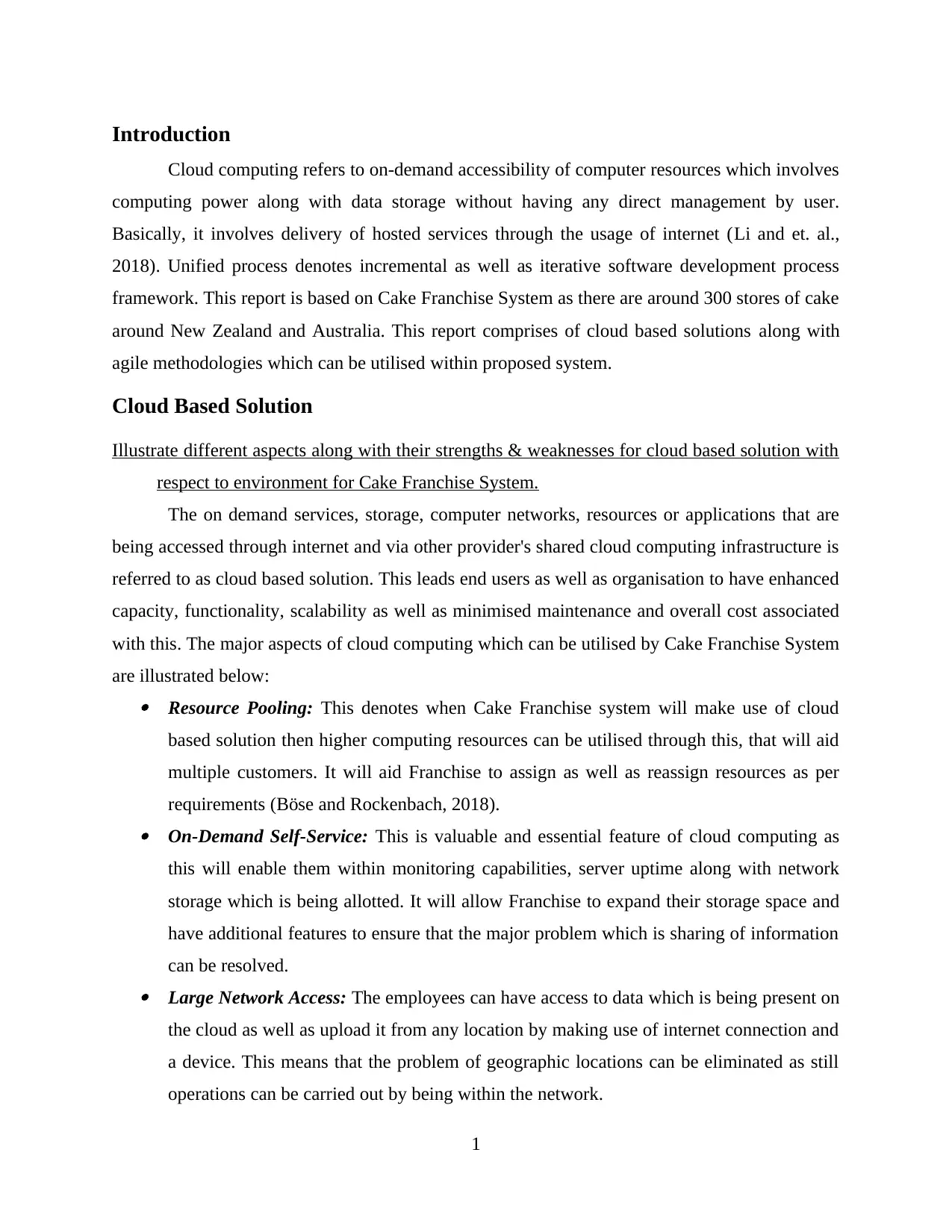
Introduction
Cloud computing refers to on-demand accessibility of computer resources which involves
computing power along with data storage without having any direct management by user.
Basically, it involves delivery of hosted services through the usage of internet (Li and et. al.,
2018). Unified process denotes incremental as well as iterative software development process
framework. This report is based on Cake Franchise System as there are around 300 stores of cake
around New Zealand and Australia. This report comprises of cloud based solutions along with
agile methodologies which can be utilised within proposed system.
Cloud Based Solution
Illustrate different aspects along with their strengths & weaknesses for cloud based solution with
respect to environment for Cake Franchise System.
The on demand services, storage, computer networks, resources or applications that are
being accessed through internet and via other provider's shared cloud computing infrastructure is
referred to as cloud based solution. This leads end users as well as organisation to have enhanced
capacity, functionality, scalability as well as minimised maintenance and overall cost associated
with this. The major aspects of cloud computing which can be utilised by Cake Franchise System
are illustrated below: Resource Pooling: This denotes when Cake Franchise system will make use of cloud
based solution then higher computing resources can be utilised through this, that will aid
multiple customers. It will aid Franchise to assign as well as reassign resources as per
requirements (Böse and Rockenbach, 2018). On-Demand Self-Service: This is valuable and essential feature of cloud computing as
this will enable them within monitoring capabilities, server uptime along with network
storage which is being allotted. It will allow Franchise to expand their storage space and
have additional features to ensure that the major problem which is sharing of information
can be resolved. Large Network Access: The employees can have access to data which is being present on
the cloud as well as upload it from any location by making use of internet connection and
a device. This means that the problem of geographic locations can be eliminated as still
operations can be carried out by being within the network.
1
Cloud computing refers to on-demand accessibility of computer resources which involves
computing power along with data storage without having any direct management by user.
Basically, it involves delivery of hosted services through the usage of internet (Li and et. al.,
2018). Unified process denotes incremental as well as iterative software development process
framework. This report is based on Cake Franchise System as there are around 300 stores of cake
around New Zealand and Australia. This report comprises of cloud based solutions along with
agile methodologies which can be utilised within proposed system.
Cloud Based Solution
Illustrate different aspects along with their strengths & weaknesses for cloud based solution with
respect to environment for Cake Franchise System.
The on demand services, storage, computer networks, resources or applications that are
being accessed through internet and via other provider's shared cloud computing infrastructure is
referred to as cloud based solution. This leads end users as well as organisation to have enhanced
capacity, functionality, scalability as well as minimised maintenance and overall cost associated
with this. The major aspects of cloud computing which can be utilised by Cake Franchise System
are illustrated below: Resource Pooling: This denotes when Cake Franchise system will make use of cloud
based solution then higher computing resources can be utilised through this, that will aid
multiple customers. It will aid Franchise to assign as well as reassign resources as per
requirements (Böse and Rockenbach, 2018). On-Demand Self-Service: This is valuable and essential feature of cloud computing as
this will enable them within monitoring capabilities, server uptime along with network
storage which is being allotted. It will allow Franchise to expand their storage space and
have additional features to ensure that the major problem which is sharing of information
can be resolved. Large Network Access: The employees can have access to data which is being present on
the cloud as well as upload it from any location by making use of internet connection and
a device. This means that the problem of geographic locations can be eliminated as still
operations can be carried out by being within the network.
1

Automatic System: Cloud Computing will be able to automatically identify information
which is needed as well as is liable for supporting metering capabilities at some level.
This will assist Franchise within monitoring, controlling as well as reporting its usage. It
enables them to have transparency among different outlets. Security: This acts as one of the best feature which is apt for Franchise to ensure that
they are able to retrieve data as it is and is not accessed by anyone else (Singh, Jeong and
Park, 2016). Here, the snapshot of data is being created so that in any case if server gets
damaged still then data can be restored.
Measured services:The cloud computing resources are being utilised for monitoring
which can be utilised by Franchise system to analyse the charge-per-use abilities.
These aspects will aid Cake Franchise System to have impelling impact and the major
problems which are being faced by them can be eliminated in an appropriate manner. Like as
traditional methods are being used then it becomes difficult for sharing the data but when cloud
is being utilised it will aid each outlet to have information from all that might lead them to have
affirmative results. An instance can be taken with respect to this like gluten free pancakes leads
to minimisation or control within celiac diseases. This implies that when this data is being
possessed by all the cake manufacturers then they can provide people of country with healthy
life. But it is not possible to communicate this data by phone calls or any other method as this
will be costly to go to 300 outlets across the country and share peculiar information. Different
types of cloud computing are illustrated below:
Public Cloud: When computing infrastructure is present on premises of cloud computing
firm which renders services. This denotes that individuals do not have physical control on the
infrastructure. The deployment model renders infrastructure as well as services to business who
tends to save cost associated with IT operational cost as it will be liability of cloud provider
(Sabi and et. al., 2016).
Strengths: High Scalability: They assist businesses to evolve at higher speed and in case of local
data centre it is not possible. With respect to this, Franchise can develop their virtual
machines which can be scaled as well as shut down at any instant. This implies that it will
enable to scale through which needs can be addressed.
2
which is needed as well as is liable for supporting metering capabilities at some level.
This will assist Franchise within monitoring, controlling as well as reporting its usage. It
enables them to have transparency among different outlets. Security: This acts as one of the best feature which is apt for Franchise to ensure that
they are able to retrieve data as it is and is not accessed by anyone else (Singh, Jeong and
Park, 2016). Here, the snapshot of data is being created so that in any case if server gets
damaged still then data can be restored.
Measured services:The cloud computing resources are being utilised for monitoring
which can be utilised by Franchise system to analyse the charge-per-use abilities.
These aspects will aid Cake Franchise System to have impelling impact and the major
problems which are being faced by them can be eliminated in an appropriate manner. Like as
traditional methods are being used then it becomes difficult for sharing the data but when cloud
is being utilised it will aid each outlet to have information from all that might lead them to have
affirmative results. An instance can be taken with respect to this like gluten free pancakes leads
to minimisation or control within celiac diseases. This implies that when this data is being
possessed by all the cake manufacturers then they can provide people of country with healthy
life. But it is not possible to communicate this data by phone calls or any other method as this
will be costly to go to 300 outlets across the country and share peculiar information. Different
types of cloud computing are illustrated below:
Public Cloud: When computing infrastructure is present on premises of cloud computing
firm which renders services. This denotes that individuals do not have physical control on the
infrastructure. The deployment model renders infrastructure as well as services to business who
tends to save cost associated with IT operational cost as it will be liability of cloud provider
(Sabi and et. al., 2016).
Strengths: High Scalability: They assist businesses to evolve at higher speed and in case of local
data centre it is not possible. With respect to this, Franchise can develop their virtual
machines which can be scaled as well as shut down at any instant. This implies that it will
enable to scale through which needs can be addressed.
2
Secure Best Marks with AI Grader
Need help grading? Try our AI Grader for instant feedback on your assignments.
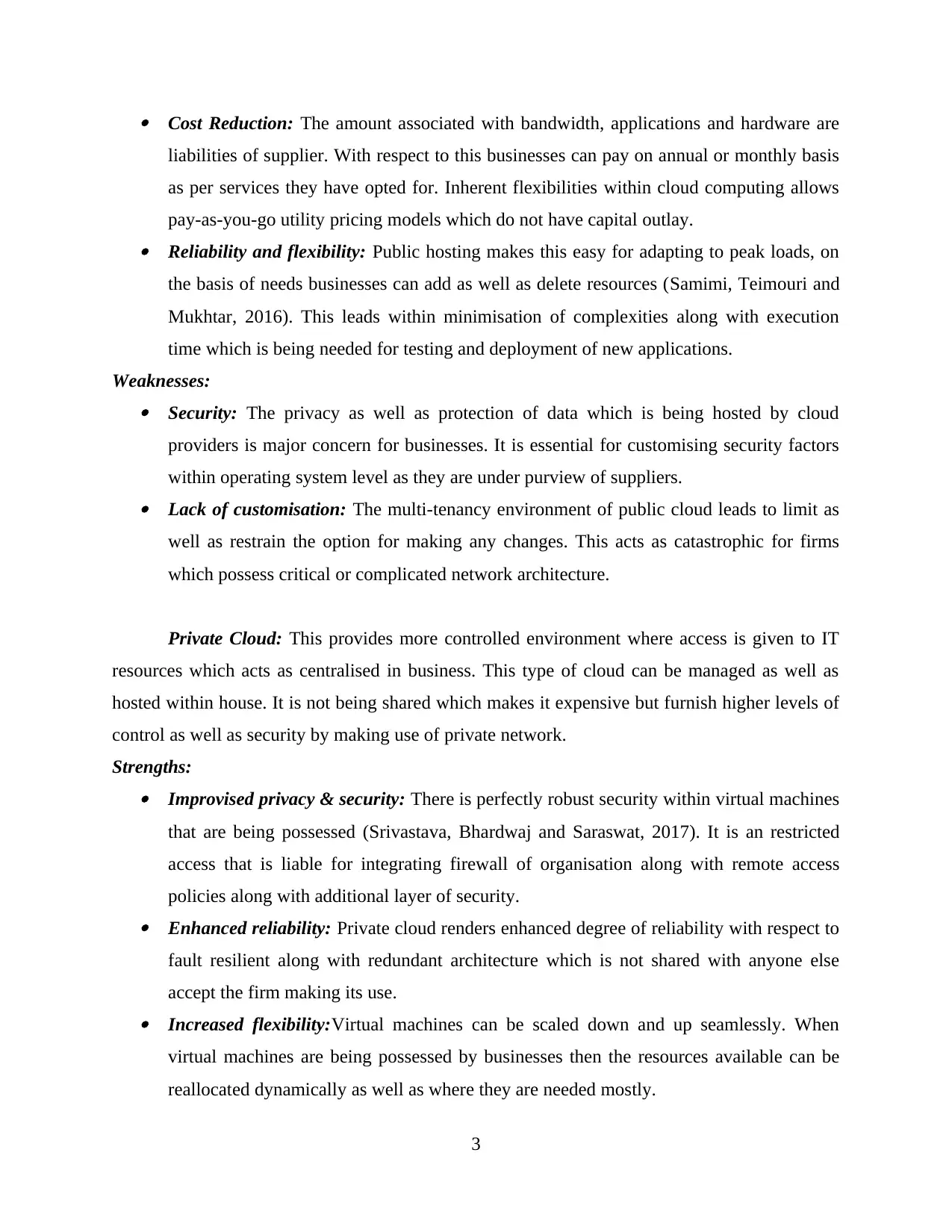
Cost Reduction: The amount associated with bandwidth, applications and hardware are
liabilities of supplier. With respect to this businesses can pay on annual or monthly basis
as per services they have opted for. Inherent flexibilities within cloud computing allows
pay-as-you-go utility pricing models which do not have capital outlay. Reliability and flexibility: Public hosting makes this easy for adapting to peak loads, on
the basis of needs businesses can add as well as delete resources (Samimi, Teimouri and
Mukhtar, 2016). This leads within minimisation of complexities along with execution
time which is being needed for testing and deployment of new applications.
Weaknesses: Security: The privacy as well as protection of data which is being hosted by cloud
providers is major concern for businesses. It is essential for customising security factors
within operating system level as they are under purview of suppliers. Lack of customisation: The multi-tenancy environment of public cloud leads to limit as
well as restrain the option for making any changes. This acts as catastrophic for firms
which possess critical or complicated network architecture.
Private Cloud: This provides more controlled environment where access is given to IT
resources which acts as centralised in business. This type of cloud can be managed as well as
hosted within house. It is not being shared which makes it expensive but furnish higher levels of
control as well as security by making use of private network.
Strengths: Improvised privacy & security: There is perfectly robust security within virtual machines
that are being possessed (Srivastava, Bhardwaj and Saraswat, 2017). It is an restricted
access that is liable for integrating firewall of organisation along with remote access
policies along with additional layer of security. Enhanced reliability: Private cloud renders enhanced degree of reliability with respect to
fault resilient along with redundant architecture which is not shared with anyone else
accept the firm making its use. Increased flexibility:Virtual machines can be scaled down and up seamlessly. When
virtual machines are being possessed by businesses then the resources available can be
reallocated dynamically as well as where they are needed mostly.
3
liabilities of supplier. With respect to this businesses can pay on annual or monthly basis
as per services they have opted for. Inherent flexibilities within cloud computing allows
pay-as-you-go utility pricing models which do not have capital outlay. Reliability and flexibility: Public hosting makes this easy for adapting to peak loads, on
the basis of needs businesses can add as well as delete resources (Samimi, Teimouri and
Mukhtar, 2016). This leads within minimisation of complexities along with execution
time which is being needed for testing and deployment of new applications.
Weaknesses: Security: The privacy as well as protection of data which is being hosted by cloud
providers is major concern for businesses. It is essential for customising security factors
within operating system level as they are under purview of suppliers. Lack of customisation: The multi-tenancy environment of public cloud leads to limit as
well as restrain the option for making any changes. This acts as catastrophic for firms
which possess critical or complicated network architecture.
Private Cloud: This provides more controlled environment where access is given to IT
resources which acts as centralised in business. This type of cloud can be managed as well as
hosted within house. It is not being shared which makes it expensive but furnish higher levels of
control as well as security by making use of private network.
Strengths: Improvised privacy & security: There is perfectly robust security within virtual machines
that are being possessed (Srivastava, Bhardwaj and Saraswat, 2017). It is an restricted
access that is liable for integrating firewall of organisation along with remote access
policies along with additional layer of security. Enhanced reliability: Private cloud renders enhanced degree of reliability with respect to
fault resilient along with redundant architecture which is not shared with anyone else
accept the firm making its use. Increased flexibility:Virtual machines can be scaled down and up seamlessly. When
virtual machines are being possessed by businesses then the resources available can be
reallocated dynamically as well as where they are needed mostly.
3

Weaknesses: Cost: While opting for private cloud this is expensive but there is a possibility to
minimise it by renting cloud from hosting service provider and have benefits from it. But
still it is more as compared to public cloud. Platform Scaling: When there are alterations within needs then scaling is required within
physical infrastructure.
Hybrid Cloud: The businesses who looks for benefits from both public as well as private
cloud deployments then hybrid is best. In this both types are being combined which furnish
tailored IT solutions for accomplishment of requirements of businesses (Sunner, 2016).
Strengths: Scalability: This implies adapting to needs which each company have in context of space,
speed and memory. The firms can have benefits from scalability of public cloud along
with minimisation of needs from private one. Security: Maintenance of security patches is time-consuming activity which can be
handled by cloud providers with pre-configured machine images which are being updated
regularly. Through minimisation of dependence on one service provider risk of system
failure can be minimised if patch of one system fails. Flexibility: It have vantage from both public as well as private cloud leads firm to have
complete range of options when it is to be selected for distinct requirements.
Weaknesses: Reliability: This factor depends on financial as well as technological capacities which are
being possessed or furnished by cloud service providers.
Centralisation: The integration of applications along with storage of data leads to
creation of interdependence on service providers (Baham and et. al., 2017).
By taking into consideration, the environments which are illustrated above along with
their strengths and weaknesses, the apt environment for Cake Franchise System will be Private
cloud computing. Though, it may seem costly but security features provided by this will yield
them affirmative results and data will not be lost. In addition to this, all the outlets can have
required information as it can be accessed by making use of their own cloud.
4
minimise it by renting cloud from hosting service provider and have benefits from it. But
still it is more as compared to public cloud. Platform Scaling: When there are alterations within needs then scaling is required within
physical infrastructure.
Hybrid Cloud: The businesses who looks for benefits from both public as well as private
cloud deployments then hybrid is best. In this both types are being combined which furnish
tailored IT solutions for accomplishment of requirements of businesses (Sunner, 2016).
Strengths: Scalability: This implies adapting to needs which each company have in context of space,
speed and memory. The firms can have benefits from scalability of public cloud along
with minimisation of needs from private one. Security: Maintenance of security patches is time-consuming activity which can be
handled by cloud providers with pre-configured machine images which are being updated
regularly. Through minimisation of dependence on one service provider risk of system
failure can be minimised if patch of one system fails. Flexibility: It have vantage from both public as well as private cloud leads firm to have
complete range of options when it is to be selected for distinct requirements.
Weaknesses: Reliability: This factor depends on financial as well as technological capacities which are
being possessed or furnished by cloud service providers.
Centralisation: The integration of applications along with storage of data leads to
creation of interdependence on service providers (Baham and et. al., 2017).
By taking into consideration, the environments which are illustrated above along with
their strengths and weaknesses, the apt environment for Cake Franchise System will be Private
cloud computing. Though, it may seem costly but security features provided by this will yield
them affirmative results and data will not be lost. In addition to this, all the outlets can have
required information as it can be accessed by making use of their own cloud.
4

Agile Methodologies
Comparison and contrast between Scrum and Unified Process.
Unified Process:
The architecture centric, iterative as well as incremental and use-case driven development
process which leverage UML (Unified Modelling Language) along with system process
engineering meta-model is referred to as unified process. Unified Process (UP) can be utilised
within distinct software systems that involves distinct managerial and technical complexities
across different organisational cultures and domains.
Use-Case Driven Approach: The communication among two or more entities is referred
to as use case. Within this, list of requirements are being transformed into functional needs via
business analysts (Kotaiah and Khalil, 2017). For an example the online cake like they can be
specified by use cases like 'add cake to cart' or 'alter the quantity' Each illustrates relevant
functionality and can be considered as iteration.
Architecture-Centric Approach: Blueprint can be created of software system of
organisation through this. For this distinct technologies, operating systems, programming
languages and server capabilities for development of system.
Iterative & Incremental Approach: This denotes that each iteration will be treated like a
mini-project which denotes that system is developed as number of small mini-projects within the
working cycles. While working on a software each iteration will lead to add functionalities with
respect to requirements.
5
Comparison and contrast between Scrum and Unified Process.
Unified Process:
The architecture centric, iterative as well as incremental and use-case driven development
process which leverage UML (Unified Modelling Language) along with system process
engineering meta-model is referred to as unified process. Unified Process (UP) can be utilised
within distinct software systems that involves distinct managerial and technical complexities
across different organisational cultures and domains.
Use-Case Driven Approach: The communication among two or more entities is referred
to as use case. Within this, list of requirements are being transformed into functional needs via
business analysts (Kotaiah and Khalil, 2017). For an example the online cake like they can be
specified by use cases like 'add cake to cart' or 'alter the quantity' Each illustrates relevant
functionality and can be considered as iteration.
Architecture-Centric Approach: Blueprint can be created of software system of
organisation through this. For this distinct technologies, operating systems, programming
languages and server capabilities for development of system.
Iterative & Incremental Approach: This denotes that each iteration will be treated like a
mini-project which denotes that system is developed as number of small mini-projects within the
working cycles. While working on a software each iteration will lead to add functionalities with
respect to requirements.
5
Paraphrase This Document
Need a fresh take? Get an instant paraphrase of this document with our AI Paraphraser
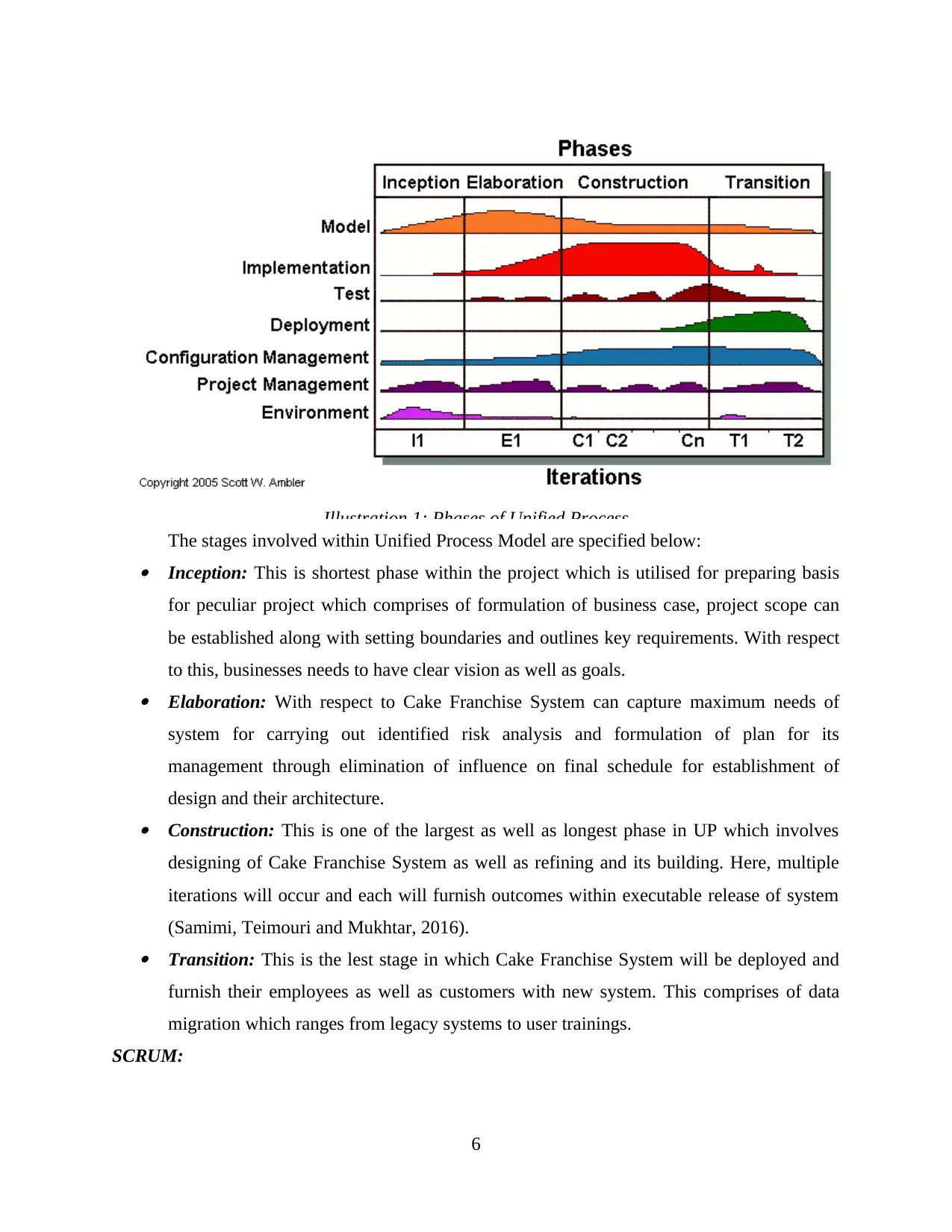
The stages involved within Unified Process Model are specified below: Inception: This is shortest phase within the project which is utilised for preparing basis
for peculiar project which comprises of formulation of business case, project scope can
be established along with setting boundaries and outlines key requirements. With respect
to this, businesses needs to have clear vision as well as goals. Elaboration: With respect to Cake Franchise System can capture maximum needs of
system for carrying out identified risk analysis and formulation of plan for its
management through elimination of influence on final schedule for establishment of
design and their architecture. Construction: This is one of the largest as well as longest phase in UP which involves
designing of Cake Franchise System as well as refining and its building. Here, multiple
iterations will occur and each will furnish outcomes within executable release of system
(Samimi, Teimouri and Mukhtar, 2016). Transition: This is the lest stage in which Cake Franchise System will be deployed and
furnish their employees as well as customers with new system. This comprises of data
migration which ranges from legacy systems to user trainings.
SCRUM:
6
Illustration 1: Phases of Unified Process
for peculiar project which comprises of formulation of business case, project scope can
be established along with setting boundaries and outlines key requirements. With respect
to this, businesses needs to have clear vision as well as goals. Elaboration: With respect to Cake Franchise System can capture maximum needs of
system for carrying out identified risk analysis and formulation of plan for its
management through elimination of influence on final schedule for establishment of
design and their architecture. Construction: This is one of the largest as well as longest phase in UP which involves
designing of Cake Franchise System as well as refining and its building. Here, multiple
iterations will occur and each will furnish outcomes within executable release of system
(Samimi, Teimouri and Mukhtar, 2016). Transition: This is the lest stage in which Cake Franchise System will be deployed and
furnish their employees as well as customers with new system. This comprises of data
migration which ranges from legacy systems to user trainings.
SCRUM:
6
Illustration 1: Phases of Unified Process
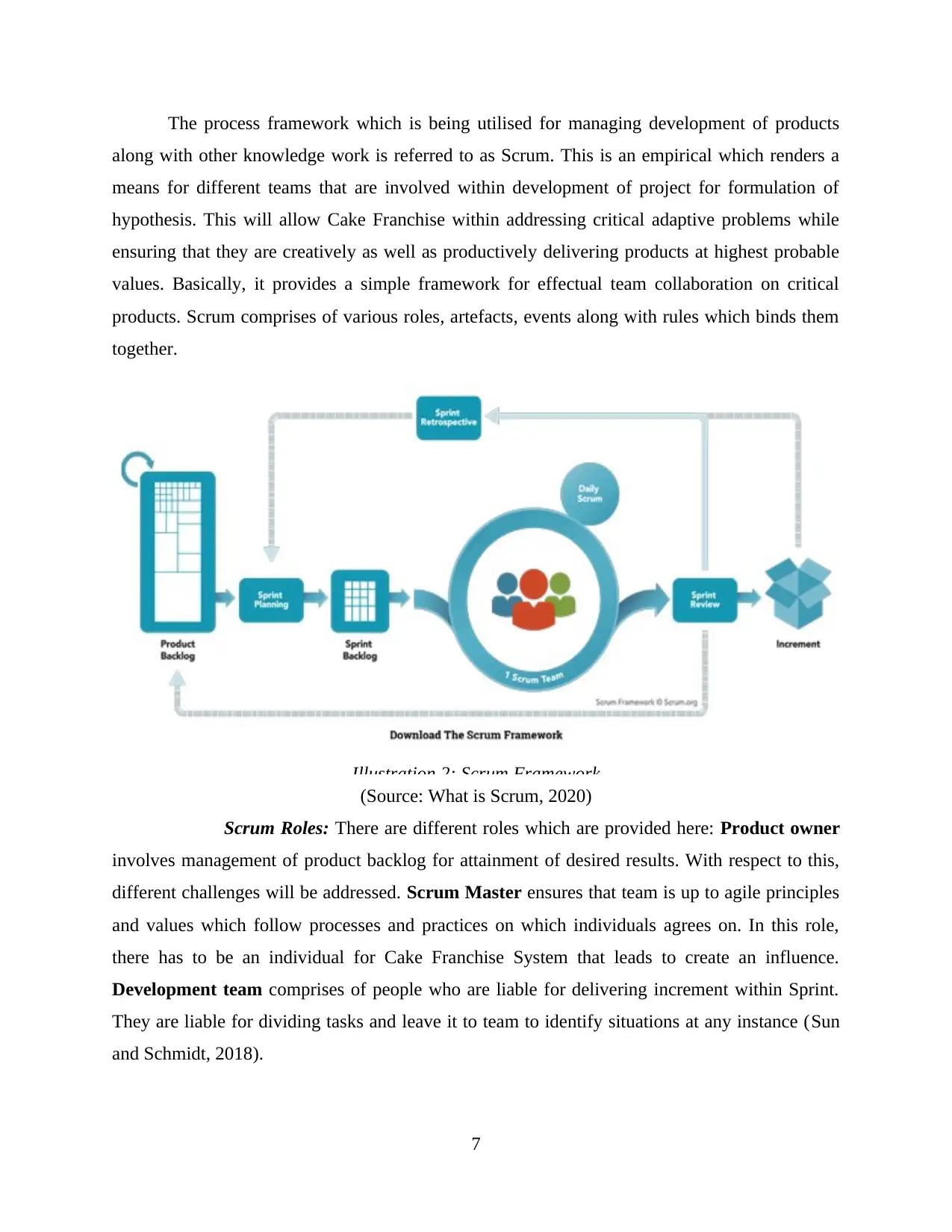
The process framework which is being utilised for managing development of products
along with other knowledge work is referred to as Scrum. This is an empirical which renders a
means for different teams that are involved within development of project for formulation of
hypothesis. This will allow Cake Franchise within addressing critical adaptive problems while
ensuring that they are creatively as well as productively delivering products at highest probable
values. Basically, it provides a simple framework for effectual team collaboration on critical
products. Scrum comprises of various roles, artefacts, events along with rules which binds them
together.
(Source: What is Scrum, 2020)
Scrum Roles: There are different roles which are provided here: Product owner
involves management of product backlog for attainment of desired results. With respect to this,
different challenges will be addressed. Scrum Master ensures that team is up to agile principles
and values which follow processes and practices on which individuals agrees on. In this role,
there has to be an individual for Cake Franchise System that leads to create an influence.
Development team comprises of people who are liable for delivering increment within Sprint.
They are liable for dividing tasks and leave it to team to identify situations at any instance (Sun
and Schmidt, 2018).
7
Illustration 2: Scrum Framework
along with other knowledge work is referred to as Scrum. This is an empirical which renders a
means for different teams that are involved within development of project for formulation of
hypothesis. This will allow Cake Franchise within addressing critical adaptive problems while
ensuring that they are creatively as well as productively delivering products at highest probable
values. Basically, it provides a simple framework for effectual team collaboration on critical
products. Scrum comprises of various roles, artefacts, events along with rules which binds them
together.
(Source: What is Scrum, 2020)
Scrum Roles: There are different roles which are provided here: Product owner
involves management of product backlog for attainment of desired results. With respect to this,
different challenges will be addressed. Scrum Master ensures that team is up to agile principles
and values which follow processes and practices on which individuals agrees on. In this role,
there has to be an individual for Cake Franchise System that leads to create an influence.
Development team comprises of people who are liable for delivering increment within Sprint.
They are liable for dividing tasks and leave it to team to identify situations at any instance (Sun
and Schmidt, 2018).
7
Illustration 2: Scrum Framework
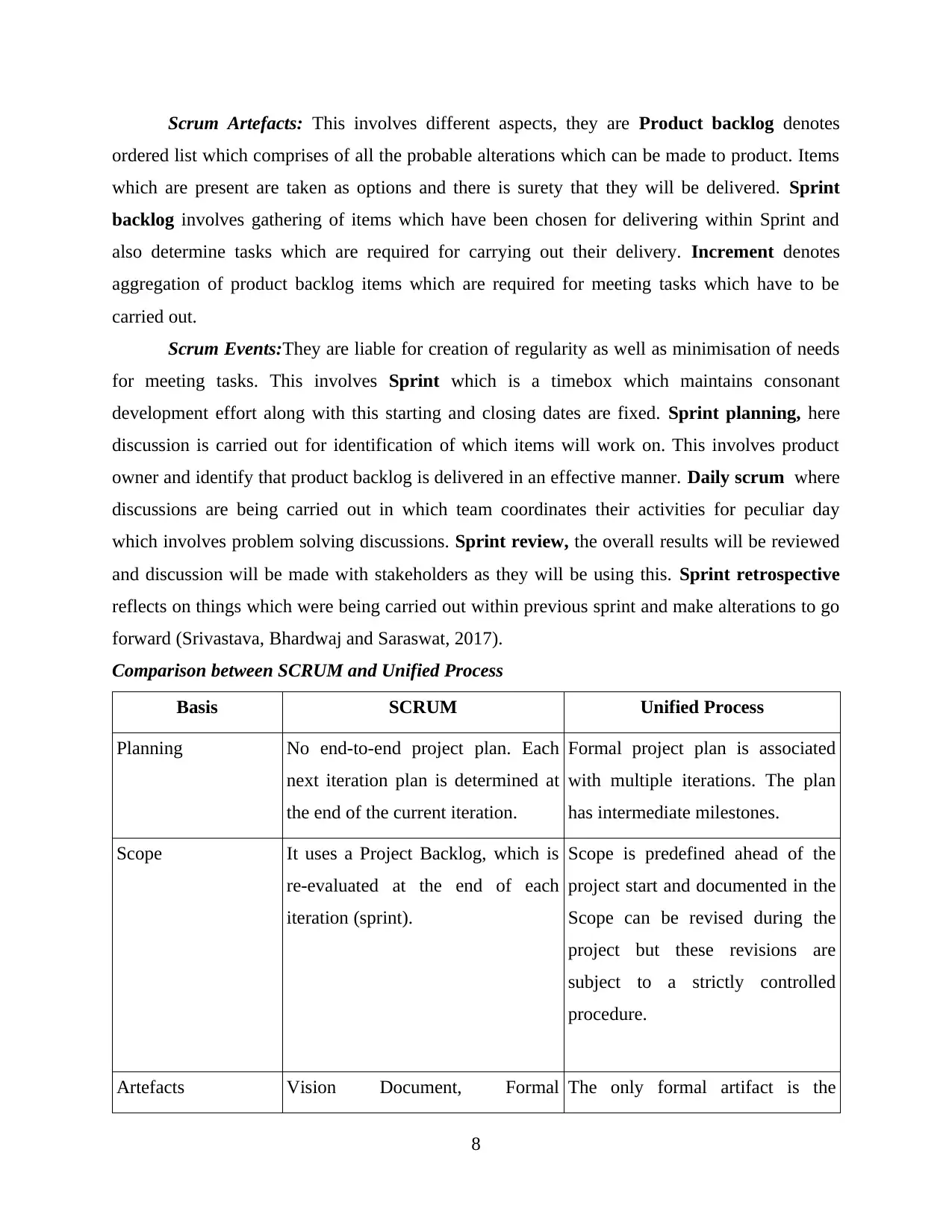
Scrum Artefacts: This involves different aspects, they are Product backlog denotes
ordered list which comprises of all the probable alterations which can be made to product. Items
which are present are taken as options and there is surety that they will be delivered. Sprint
backlog involves gathering of items which have been chosen for delivering within Sprint and
also determine tasks which are required for carrying out their delivery. Increment denotes
aggregation of product backlog items which are required for meeting tasks which have to be
carried out.
Scrum Events:They are liable for creation of regularity as well as minimisation of needs
for meeting tasks. This involves Sprint which is a timebox which maintains consonant
development effort along with this starting and closing dates are fixed. Sprint planning, here
discussion is carried out for identification of which items will work on. This involves product
owner and identify that product backlog is delivered in an effective manner. Daily scrum where
discussions are being carried out in which team coordinates their activities for peculiar day
which involves problem solving discussions. Sprint review, the overall results will be reviewed
and discussion will be made with stakeholders as they will be using this. Sprint retrospective
reflects on things which were being carried out within previous sprint and make alterations to go
forward (Srivastava, Bhardwaj and Saraswat, 2017).
Comparison between SCRUM and Unified Process
Basis SCRUM Unified Process
Planning No end-to-end project plan. Each
next iteration plan is determined at
the end of the current iteration.
Formal project plan is associated
with multiple iterations. The plan
has intermediate milestones.
Scope It uses a Project Backlog, which is
re-evaluated at the end of each
iteration (sprint).
Scope is predefined ahead of the
project start and documented in the
Scope can be revised during the
project but these revisions are
subject to a strictly controlled
procedure.
Artefacts Vision Document, Formal The only formal artifact is the
8
ordered list which comprises of all the probable alterations which can be made to product. Items
which are present are taken as options and there is surety that they will be delivered. Sprint
backlog involves gathering of items which have been chosen for delivering within Sprint and
also determine tasks which are required for carrying out their delivery. Increment denotes
aggregation of product backlog items which are required for meeting tasks which have to be
carried out.
Scrum Events:They are liable for creation of regularity as well as minimisation of needs
for meeting tasks. This involves Sprint which is a timebox which maintains consonant
development effort along with this starting and closing dates are fixed. Sprint planning, here
discussion is carried out for identification of which items will work on. This involves product
owner and identify that product backlog is delivered in an effective manner. Daily scrum where
discussions are being carried out in which team coordinates their activities for peculiar day
which involves problem solving discussions. Sprint review, the overall results will be reviewed
and discussion will be made with stakeholders as they will be using this. Sprint retrospective
reflects on things which were being carried out within previous sprint and make alterations to go
forward (Srivastava, Bhardwaj and Saraswat, 2017).
Comparison between SCRUM and Unified Process
Basis SCRUM Unified Process
Planning No end-to-end project plan. Each
next iteration plan is determined at
the end of the current iteration.
Formal project plan is associated
with multiple iterations. The plan
has intermediate milestones.
Scope It uses a Project Backlog, which is
re-evaluated at the end of each
iteration (sprint).
Scope is predefined ahead of the
project start and documented in the
Scope can be revised during the
project but these revisions are
subject to a strictly controlled
procedure.
Artefacts Vision Document, Formal The only formal artifact is the
8
Secure Best Marks with AI Grader
Need help grading? Try our AI Grader for instant feedback on your assignments.
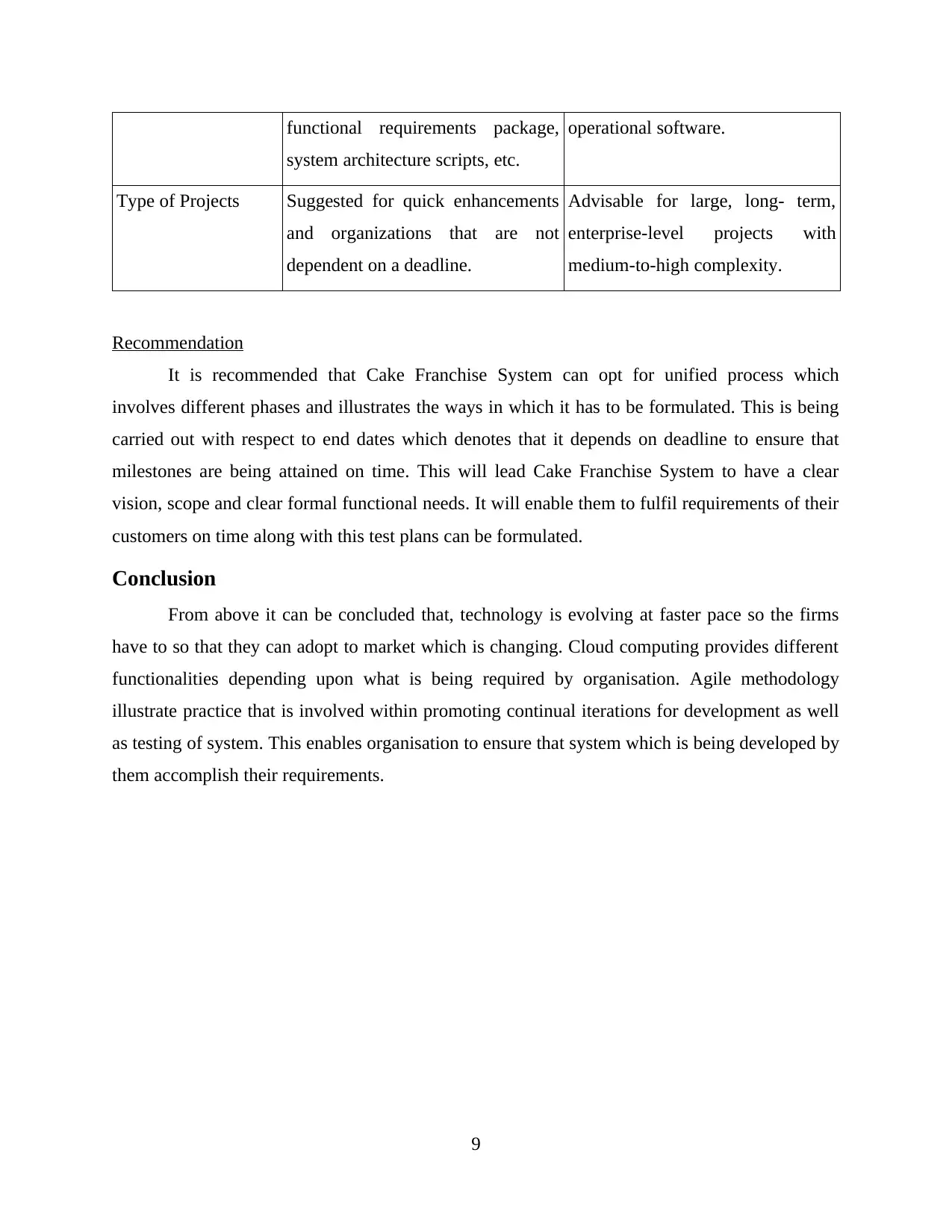
functional requirements package,
system architecture scripts, etc.
operational software.
Type of Projects Suggested for quick enhancements
and organizations that are not
dependent on a deadline.
Advisable for large, long- term,
enterprise-level projects with
medium-to-high complexity.
Recommendation
It is recommended that Cake Franchise System can opt for unified process which
involves different phases and illustrates the ways in which it has to be formulated. This is being
carried out with respect to end dates which denotes that it depends on deadline to ensure that
milestones are being attained on time. This will lead Cake Franchise System to have a clear
vision, scope and clear formal functional needs. It will enable them to fulfil requirements of their
customers on time along with this test plans can be formulated.
Conclusion
From above it can be concluded that, technology is evolving at faster pace so the firms
have to so that they can adopt to market which is changing. Cloud computing provides different
functionalities depending upon what is being required by organisation. Agile methodology
illustrate practice that is involved within promoting continual iterations for development as well
as testing of system. This enables organisation to ensure that system which is being developed by
them accomplish their requirements.
9
system architecture scripts, etc.
operational software.
Type of Projects Suggested for quick enhancements
and organizations that are not
dependent on a deadline.
Advisable for large, long- term,
enterprise-level projects with
medium-to-high complexity.
Recommendation
It is recommended that Cake Franchise System can opt for unified process which
involves different phases and illustrates the ways in which it has to be formulated. This is being
carried out with respect to end dates which denotes that it depends on deadline to ensure that
milestones are being attained on time. This will lead Cake Franchise System to have a clear
vision, scope and clear formal functional needs. It will enable them to fulfil requirements of their
customers on time along with this test plans can be formulated.
Conclusion
From above it can be concluded that, technology is evolving at faster pace so the firms
have to so that they can adopt to market which is changing. Cloud computing provides different
functionalities depending upon what is being required by organisation. Agile methodology
illustrate practice that is involved within promoting continual iterations for development as well
as testing of system. This enables organisation to ensure that system which is being developed by
them accomplish their requirements.
9
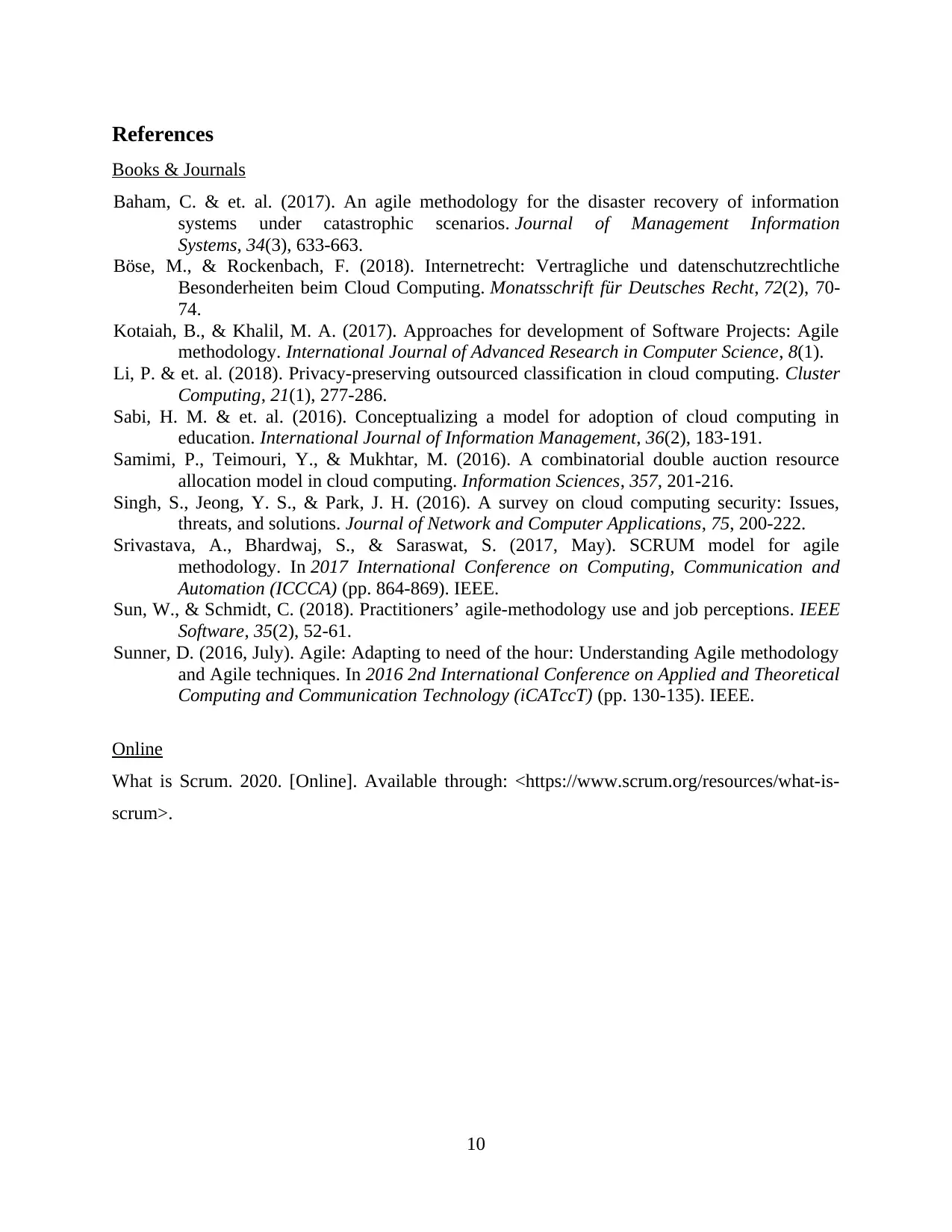
References
Books & Journals
Baham, C. & et. al. (2017). An agile methodology for the disaster recovery of information
systems under catastrophic scenarios. Journal of Management Information
Systems, 34(3), 633-663.
Böse, M., & Rockenbach, F. (2018). Internetrecht: Vertragliche und datenschutzrechtliche
Besonderheiten beim Cloud Computing. Monatsschrift für Deutsches Recht, 72(2), 70-
74.
Kotaiah, B., & Khalil, M. A. (2017). Approaches for development of Software Projects: Agile
methodology. International Journal of Advanced Research in Computer Science, 8(1).
Li, P. & et. al. (2018). Privacy-preserving outsourced classification in cloud computing. Cluster
Computing, 21(1), 277-286.
Sabi, H. M. & et. al. (2016). Conceptualizing a model for adoption of cloud computing in
education. International Journal of Information Management, 36(2), 183-191.
Samimi, P., Teimouri, Y., & Mukhtar, M. (2016). A combinatorial double auction resource
allocation model in cloud computing. Information Sciences, 357, 201-216.
Singh, S., Jeong, Y. S., & Park, J. H. (2016). A survey on cloud computing security: Issues,
threats, and solutions. Journal of Network and Computer Applications, 75, 200-222.
Srivastava, A., Bhardwaj, S., & Saraswat, S. (2017, May). SCRUM model for agile
methodology. In 2017 International Conference on Computing, Communication and
Automation (ICCCA) (pp. 864-869). IEEE.
Sun, W., & Schmidt, C. (2018). Practitioners’ agile-methodology use and job perceptions. IEEE
Software, 35(2), 52-61.
Sunner, D. (2016, July). Agile: Adapting to need of the hour: Understanding Agile methodology
and Agile techniques. In 2016 2nd International Conference on Applied and Theoretical
Computing and Communication Technology (iCATccT) (pp. 130-135). IEEE.
Online
What is Scrum. 2020. [Online]. Available through: <https://www.scrum.org/resources/what-is-
scrum>.
10
Books & Journals
Baham, C. & et. al. (2017). An agile methodology for the disaster recovery of information
systems under catastrophic scenarios. Journal of Management Information
Systems, 34(3), 633-663.
Böse, M., & Rockenbach, F. (2018). Internetrecht: Vertragliche und datenschutzrechtliche
Besonderheiten beim Cloud Computing. Monatsschrift für Deutsches Recht, 72(2), 70-
74.
Kotaiah, B., & Khalil, M. A. (2017). Approaches for development of Software Projects: Agile
methodology. International Journal of Advanced Research in Computer Science, 8(1).
Li, P. & et. al. (2018). Privacy-preserving outsourced classification in cloud computing. Cluster
Computing, 21(1), 277-286.
Sabi, H. M. & et. al. (2016). Conceptualizing a model for adoption of cloud computing in
education. International Journal of Information Management, 36(2), 183-191.
Samimi, P., Teimouri, Y., & Mukhtar, M. (2016). A combinatorial double auction resource
allocation model in cloud computing. Information Sciences, 357, 201-216.
Singh, S., Jeong, Y. S., & Park, J. H. (2016). A survey on cloud computing security: Issues,
threats, and solutions. Journal of Network and Computer Applications, 75, 200-222.
Srivastava, A., Bhardwaj, S., & Saraswat, S. (2017, May). SCRUM model for agile
methodology. In 2017 International Conference on Computing, Communication and
Automation (ICCCA) (pp. 864-869). IEEE.
Sun, W., & Schmidt, C. (2018). Practitioners’ agile-methodology use and job perceptions. IEEE
Software, 35(2), 52-61.
Sunner, D. (2016, July). Agile: Adapting to need of the hour: Understanding Agile methodology
and Agile techniques. In 2016 2nd International Conference on Applied and Theoretical
Computing and Communication Technology (iCATccT) (pp. 130-135). IEEE.
Online
What is Scrum. 2020. [Online]. Available through: <https://www.scrum.org/resources/what-is-
scrum>.
10
1 out of 12
Related Documents
Your All-in-One AI-Powered Toolkit for Academic Success.
+13062052269
info@desklib.com
Available 24*7 on WhatsApp / Email
![[object Object]](/_next/static/media/star-bottom.7253800d.svg)
Unlock your academic potential
© 2024 | Zucol Services PVT LTD | All rights reserved.





